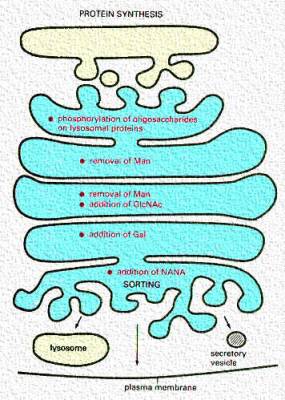The important role of the Golgi Complex is to make certain the plasma membrane proteins reach their destination. This figure shows the route. Note that the orientation of the protein is maintained so that the region destined to project outside the cell (a receptor binding site, for example), ends up in that place. In order to do this, it must be placed so that it faces inside the vesicle.
The Golgi complex is compartmentalized. Phosphorylation occurs in the Cis region. In other regions, different types of carbohydrates are added as a glycoprotein passes through the cisternae. This figure illustrates the different regions where sugars like mannose (man), galactose (gal), etc are added. The final sorting is done in the Trans Golgi complex.
The functional differentiation of the Golgi complex can be studied with the electron microscope with specific techniques that detect enzymes. The cis region is rich in lipid-bearing membranes and can be delineated by osmium tetroxide labeling. The middle regions label for enzymes that add carbohydrates or other groups on the product. The inner, or Trans region, is the area where the lysosomes are sorted. Therefore, it is heavily labeled for acid phosphatase.
There is much interest in understanding how the different Golgi cisternae are organized and differentiated. A number of models exist, however a favorite is called the "Maturational model" (Bannykh S.I. and Bakch, W.E. Membrane Dynamics at the Endoplasmic Reticulum Golgi Interface J Cell Biol 138: 1-4 1997)

This model suggests that the new vesicles from the ER enter the cis Golgi network and retrograde vesicles (bearing COPI) coats move to merge with the cis region cisternae. These carry Golgi complex processing enzymes and their targeting to this region may be dependent on the low concentration of these processing enzymes. Then, as processing continues, the middle cisternae contain more mature product and lower amounts of the enzymes needed in the beginning. Finally, the trans region is specialized for sorting, containing receptors to sort and isolate lysosomal enzymes, for example.
For more information about modern studies that address this question, see: Wooding, S and H.R.B. Pelham, The dynamics of Golgi protein traffic visualized in living yeast cells. Molecular biology of the cell. 9: 2667-2680 1998




